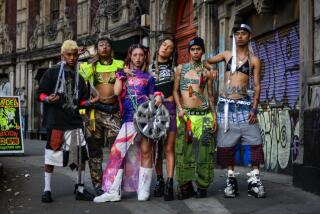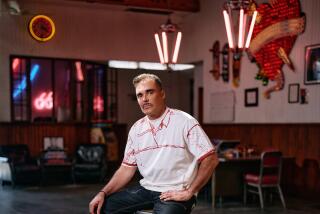Review: Zackary Drucker and Rhys Ernst, from many angles
America in general and Los Angeles in particular have a reputation as places for a second chance, places where anyone might reinvent a self. Photographers and filmmakers Zackary Drucker and Rhys Ernst are emblematic – and in mind-and-body-bending ways. Their work moves forward propositions perhaps first encountered 20 years ago in Cathy Opie’s widely acclaimed art.
At Luis De Jesus Gallery, Drucker and Ernst show two videos and a selection of 62 color photographs that were featured in the Whitney Museum’s Biennial this year. “Relationship” documents theirs, over the course of nearly six years.
The pictures aren’t comprehensive, probing every nook and cranny of their lives together. Nor do they capture dramatic moments of interaction.
Instead, they are almost entirely capital-R Romantic portraits – often dreamy, preternaturally still and imbued with clear and gentle light – of one or the other, or of the couple together.
Some compositions are simply coded. A young man stands stock-still in a spectacular, unreal field of brightly blooming daisies. He loves me, he loves me not.
Others are more complex. A soft and seductive body dressed only in a camisole lies in a rumpled bed, shown from behind like a Titian reclining nude or the classical Roman “Sleeping Hermaphrodite.” A bracelet-bedecked arm is raised aloft and holds a syringe, which is being injected into the naked left buttock.
Further complicating “Relationship” is its status as a record of a transgender couple. Their bodies are transitioning in opposite directions (for Drucker from male to female, and for Ernst from female to male). The relationship triples. It encompasses each person’s physical interaction with him- and herself; the one between the protagonists; and, finally, the relationship of the photographs to a viewer.
Perhaps it even quadruples. Prior to their transition, Drucker and Ernst might have self-identified as homosexual. After, they might self-identify as heterosexual. Or they may well regard gender and sexual identity as instead far more fluid and ambiguous than most people do.
The setup for one of the videos underscores the point. Resting on top of the video monitor, where a meditation on the couple unfolds (the other, more elaborate video hinges on a drag-dream), a framed still-photograph shows them seated side by side in blue sling-chairs. Drucker glances to the side at Ernst, who looks straight ahead through the camera lens at you.
The actual sling-chairs have been placed in front of the monitor. Silently they invite a viewer to sit and watch – and, perhaps, to take a sidewise glance at whoever might be seated next to you.
There is something almost Pre-Raphaelite about the tone and feeling of the Drucker-Ernst display. Both noble and, in the best sense, moralizing, it offers the self-reflective pleasures of a secret society unveiled.
Luis De Jesus Gallery, 2685 S. La Cienega Blvd., Culver City, (310) 838-6000, through Nov. 1. Closed Sun. and Mon. www.luisdejesus.com
More to Read
The biggest entertainment stories
Get our big stories about Hollywood, film, television, music, arts, culture and more right in your inbox as soon as they publish.
You may occasionally receive promotional content from the Los Angeles Times.











